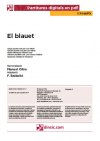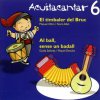
Down to his retirement in 1987, he taught harmony, counterpoint and form at the Barcelona Music School, he also having given classes at the Spanish-Moroccan Music School in Tetuan and in the Institut de Rítmica Joan Llongueres.
He directed a number of artistic and traditional groups, and is much sought after for giving courses and master classes on various aspects of the practice and the teaching of music.
His output as a composer is extensive and varied, including nearly every genre: lieder, chamber music, choral works with instrumental accompaniment or a cappella, symphonic works and numerous arrangements of traditional music for various ensembles.
He won the composition award in the Autonomous Government of Catalonia's National Music Prize, and the music award in the National Prize for Folk and Traditional Culture.
The Author
Manuel Oltra i Ferrer was born in Valencia in 1922, though his family moved to Barcelona that same year. He taught harmony, counterpoint and musical form at the Barcelona music school from 1959 to 1987, he also having held the post of vice-director there (1973-1981). Manuel Oltra's teaching work there has left a deep impression on a whole generation of musicians, among whom are some of the most representative figures of the present-day musical world.
Alongside that academic work, his professional work was strongly bound up with the worlds of choral singing and the traditional song-and-dance esbarts, his extensive knowledge of music in general having taken him into practically every musical genre: chamber music, orchestral music, 'a capella' choral works, choral-symphonic music etc. It is thus from this wide-ranging musical perspective that he came to the music of our land in its most characteristic soundscape ' the cobla band ' and in its most genuine expression ' the sardana.
Manuel Oltra is regarded as having carried on the work of the classic figures of cobla music: the likes of Eduard Toldrà, Ricard Lamote de Grignon and in particular Joanquim Serra, with whom he shared interesting musical experiences in his youth, became beacon figures, revered as masters. His musical output in general is characterised by balanced proportions in every sense, whether in the creation of unusual structures or in developing pre-established forms. The balance between unity and variety and between moments of tension and of relaxation, and the quest for reaching the climax at the most appropriate time (the golden section or proportion) are some of the elements frequently cited by Manuel Oltra in talking about music in general and his own in particular, in which the treatment of the instruments tends to have a certain chamber-music quality: according to him, economy of means in instrumental writing offers him greater possibilities as regards combining different timbres. His harmonies often have a certain post-impressionist flavour: the tonal explorations along with the modal nature thriving in many of his ideas or musical phrases sometimes lead to curious harmonic symbioses.
Manuel Oltra's output for cobla band comprises, in addition his harmonisations of a hundred-odd traditional Catalan ballets, a dozen long concert works, varying in form, length and orchestration, and a catalogue of sardanas that now stands at 36 works. His constant probing has led to bold and apposite experiments in timbre ' he was the first composer to combine the cobla band with instruments not associated with the traditional ensemble ' and to successful rhythmic speculations.
Jordi León
















